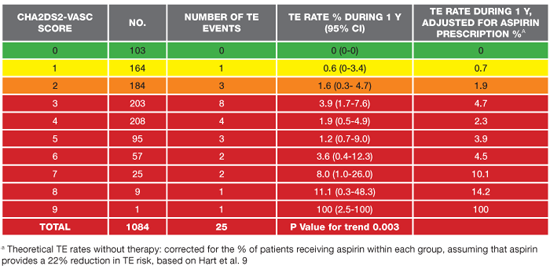Atrial Fibrillation
Decision Aide (continued)
Stroke or Other TE (Thromboembolic) at 1 Year Based on the 2009 Birmingham
(CHA2DS 2-VASc) Scoring System
This table presents the risk of stroke or thromboembolism over one year of follow-up stratified by age and risk factors.

Recommendations for Anticoagulation (Based on CHADS2 Index):
Recommendations are based on the Eighth (2008) ACCP Guidelines for Antithrombotic Therapy for Prevention and Treatment of Thrombosis (CHEST 2008; 133 (6), supplement). Dabigatran was approved after these guidelines were published and has been approved for use in Canada in the prevention of stroke or systemic embolization in patients with atrial fibrillation. See CCS 2010 Atrial Fibrillation Guidelines.

Warfarin vs. Dabigatran
Warfarin (Coumadin®) therapy requires frequent blood monitoring of prothrombin time (PT) or INR. Patients with atrial fibrillation require an INR of 2.5 (range between 2 and 3) to ensure optimal stroke risk reduction. Warfarin dose is adjusted according to periodic blood tests in order to maintain the INR in the therapeutic range (2 to 3). Dabigatran is a direct thrombin inhibitor. It does not require anticoagulation monitoring however it must be administered twice daily for anticoagulation effect. In the recently published RE-LY Study, low dose Dabigatran has been shown to be as effective as Warfarin in preventing stroke or systemic embolization and high dose Dabigatran has been shown to more effective than Warfarin in preventing stroke or systemic embolization. NB: Dabigatran is contraindicated in chronic kidney disease with eGFR < 30 ml/minute.
Continue to next page >
|